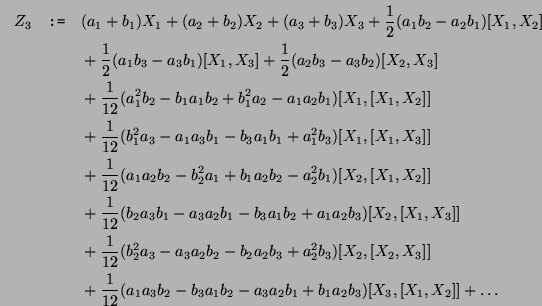



Next: Example 1: Stabilization of
Up: Using LTP: Some Practical
Previous: Using LTP: Some Practical
Contents
To explain some of the capabilities of the package we consider a few examples.
To simplify the following expression
![$x:=[\alpha X_3,[\alpha X_2, (\alpha+\beta^2) X_1 ] ] )$](img290.png) , in which
, in which  and
and  are considered to be symbolic scalars,
the function y:=simpLB(x) is invoked and returns the result:
are considered to be symbolic scalars,
the function y:=simpLB(x) is invoked and returns the result:
![$(\alpha^3+\alpha^2\beta^2) [X_3,[X_2,X_1]]$](img293.png) , as well as, but separately,
the scalar part of it,
, as well as, but separately,
the scalar part of it,
 , and the Lie monomial
, and the Lie monomial
![$[X_3,[X_2,X_1]]$](img295.png) . Such an answer form facilitates further calculations; for example when the expression needs to be rewritten in terms of elements of the basis
. Such an answer form facilitates further calculations; for example when the expression needs to be rewritten in terms of elements of the basis  . The latter can be accomplished by subsequently invoking the function phbize(y[3]), which acts on the third argument of the result.
Another example, where skillful simplification is essential, is provided by the composition of exponential mappings
. The latter can be accomplished by subsequently invoking the function phbize(y[3]), which acts on the third argument of the result.
Another example, where skillful simplification is essential, is provided by the composition of exponential mappings
 , with
, with  and
and  declared as two simple Lie polynomials:
declared as two simple Lie polynomials:
 ,
,
 , and with
, and with  ,
,  ,
,  , declared as symbolic scalars. Employing the CBH formula in Dynkin's form, (3), a truncation of the series for
, declared as symbolic scalars. Employing the CBH formula in Dynkin's form, (3), a truncation of the series for  involving brackets up to order
involving brackets up to order  is obtained by invoking first the function cbhexp(
is obtained by invoking first the function cbhexp( ,
, ,n). This produces a complicated expression involving 231 Lie products of indeterminates, which are further simplified by executing the function reduceLB(
,n). This produces a complicated expression involving 231 Lie products of indeterminates, which are further simplified by executing the function reduceLB( ,
, ). This reduces
). This reduces  into its expression in the Hall basis
into its expression in the Hall basis  which, in this particular case, counts only 29 components. The first 12 terms of the final result are shown below:
which, in this particular case, counts only 29 components. The first 12 terms of the final result are shown below:




Next: Example 1: Stabilization of
Up: Using LTP: Some Practical
Previous: Using LTP: Some Practical
Contents
Miguel Attilio Torres-Torriti
2004-05-31
 is obtained by invoking first the function cbhexp(
is obtained by invoking first the function cbhexp(